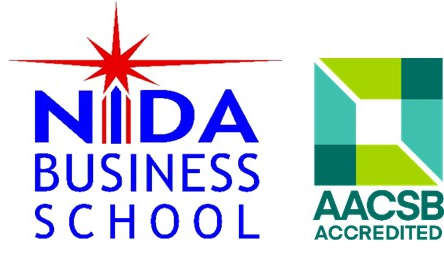การศึกษาภาวะผู้นำสำหรับผู้ประกอบการและการสร้างสรรค์นวัตกรรม ที่ส่งผลต่อความได้เปรียบทางการแข่งขันของวิสาหกิจ ขนาดกลางและขนาดย่อม จังหวัดกาญจนบุรี
คำสำคัญ:
ภาวะผู้นำสำหรับผู้ประกอบการร, การสร้างสรรค์นวัตกรรม, ความได้เปรียบทางการแข่งขันบทคัดย่อ
การวิจัยครั้งนี้มีวัตถุประสงค์เพื่อศึกษาอิทธิพลของภาวะความเป็นผู้นำสำหรับผู้ประกอบการและการสร้างสรรค์ นวัตกรรม ที่ส่งผลต่อความได้เปรียบทางการแข่งขันของวิสาหกิจขนาดกลางและขนาดย่อม จังหวัดกาญจนบุรี และศึกษา ความสอดคล้องของโมเดลภาวะผู้นำสำหรับผู้ประกอบการและการสร้างสรรค์นวัตกรรม ที่ส่งผลต่อความได้เปรียบทาง การแข่งขันของวิสาหกิจขนาดกลางและขนาดย่อม จังหวัดกาญจนบุรี กับข้อมูลเชิงประจักษ์ เป็นการวิจัยเชิงสำรวจโดยใช้ แบบสอบถามในการเก็บข้อมูล จากนั้นทำการเก็บข้อมูลจากกลุ่มตัวอย่างทั้งสิ้น 450 คน จากกลุ่มตัวอย่างแบบเจาะจง โดยใช้สถิติทางการวิจัย ได้แก่ ค่าร้อยละ ค่าเฉลี่ย ส่วนเบี่ยงเบนมาตรฐาน การวิเคราะห์ความสัมพันธ์ระหว่างตัวแปรอิสระ โดยใช้ค่าสหสัมพันธ์เพียร์สันและสถิติการวิเคราะห์โมเดลสมการโครงสร้าง ผลการวิจัยพบว่าโมเดลหลังจากผู้วิจัยทำการ ปรับปรุงและพัฒนาขึ้นมีความสอดคล้องของโมเดลกับข้อมูลเชิงประจักษ์ โดยมีค่าดัชนีความสอดคล้อง ดังนี้ Chi-square = 22.456, df = 20, Chi-square/df = 1.123, P-value = 0.316, GFI = 0.990, NFI = 0.993, CFI = 0.999, RMSEA = 0.017 และ RMR = 0.004 และจากผลการทดสอบโมเดลสมการโครงสร้างภาวะผู้นำสำหรับผู้ประกอบการและ การสร้างสรรค์นวัตกรรม ที่ส่งผลต่อความได้เปรียบทางการแข่งขันของวิสาหกิจขนาดกลางและขนาดย่อม จังหวัดกาญจนบุรี พบว่าภาวะผู้นำสำหรับผู้ประกอบการมีอิทธิพลทางตรงเชิงบวกต่อความได้เปรียบทางการแข่งขันของวิสาหกิจขนาดกลาง และขนาดย่อม จังหวัดกาญจนบุรี และภาวะผู้นำสำหรับผู้ประกอบการมีอิทธิพลทางอ้อมเชิงบวก โดยผ่านการสร้างสรรค์ นวัตกรรมต่อความได้เปรียบทางการแข่งขันของวิสาหกิจขนาดกลางและขนาดย่อม จังหวัดกาญจนบุรี ซึ่งสามารถนำข้อมูลนี้ ไปใช้สำหรับการวางแผนเพื่อพัฒนาคุณภาพและศักยภาพของผู้ประกอบการวิสาหกิจขนาดกลางและขนาดย่อม จังหวัด กาญจนบุรี ให้มีความรู้ ความสามารถ และศักยภาพที่เพียงพอต่อความต้องการ และทันต่อการเปลี่ยนแปลงในอนาคต
References
Altuntas, G. (2010). Girisimcilik ve Stratejik Yonetim Iliskisi: Bir Stratejik Girisimcilik Modeli ve IMKB Ulusal 100 Endeksinde Islem Goren Isletmeler Uzerinde Testi. Istanbul: Istanbul Universitesi Sosyal Bilimler Enstitusu, Doktora Tezi.
Asst. Prof. Nikom, T. (2007). Questionnaire Quality Inspection. Khon Kaen: Department of Biostatistics and Demography, Faculty of public health, Khon Kaen University.
Amabile, T. M. (1998). “How to Kill Creativity.” Harvard Business Review. Boston: Harvard Business School Press.
Boonthawan, W. (2013). Being entrepreneur of globalization. Bangkok: Chulalongkorn University.
Chanthima, P., Jakret, M., & Wannida, S. (2016). Effects of Modern Entrepreneurial Capability and Marketing Innovation on Competitive Advantage of Community Enterprises Processing Agricultural Products in Upper Northeast. Suranaree Journal of Social Science, 79-96.
Dr.Suphakorn, s. (2020). How are you living in the VUCA world? Bangkok: Bangkok Biz News.
Dr.Wichai, w., & Assoc. Prof. Marut, p. (2019). Innovation Skills Development. Bangkok: Center for Innovation Leaders in Curriculum and Learning.
Cronbach, L. J. (1970). Essential of Psychological Test. 5th ed.. New York: Harper Collins.
Dessler, G. (1998). Management: Leading People and Organizations in the 21st ed.. New Jersey: PrenticeHall International.
Esmer, Y., & Dayi, F. (2017). Entrepreneurial Leadership: A Theoretical Framework. Mehmet Akif Ersoy Universitesi Iktisadi ve Idari Bilimler Fakultesi Dergisi, 112-124.
Greenberg, J., & Baron, R. A. (2003). Behavior in Organizations: Under Stanadingand Managing the Human Side of Work. 8th ed.. Englewood Cliffs, New Jersey: Prentice Hall.
Hair, J., Black, W., Babin, B., & Anderson, R. (2010). Multivariate Data Analysis. (7th ed.). Upper saddle Reiver New Jersey: Person Education Internation.
Hinkle, D., William, W., & Stephen, G. (1998). Applied Statistics for the Behavior Sciences. 4th ed.. New York: Houghton Mifflin.
Hisrich, R., Peters, M., & Shepherd, D. (2008). Entrepreneurship. 7th Edition. Boston: McGraw-Hill International Edition.
Jaruwan, M., & Prasopchai, P. (2019). Creative Innovation in the Work Process Affecting the Performance Effectiveness of Employees at Convenience Stores in the Bangkok Metropolitan Area. Journal of Economics and Management Strategy, 73-88.
Kline, R. B. (2013). Exploratory and confirmatoryfactor analysis. In Applied Quantitative Analysis in the Social Sciences (pp. 171-207). New York: Routledge: Y. Petscher & C. Schatsschneider (Eds.).
Labor office in Kanchanaburi. (2021). Labor Situation Report for the First Quarter of 2021. Kanchanaburi: Labor office in Kanchanaburi.
Magazine, B. O. (2020). Thai Economy in a Transformative World. Thailand: Bank of Thailand.
Office of Small and Medium Enterprise. (2019). Determine the Characteristics of Small and Medium Enterprises. Bangkok: Office of Small and Medium Enterprise Promotion.
Office of Small and Medium Enterprises. (2021, July 30). Dashboard SME Big Data. Retrieved from Situation and Knowledge: https://www.sme.go.th/
Pensuk, K., Woraluck, L., S. T., & Korkaew, J. (2018). Competitive Advantage of SMEs in Thailand 4.0. Humanities and Social Sciences Mahasarakham University, 245-256.
Porter, M. E. (1980). Competitive Strategy. New York: Free Press.
Porter, M. E. (1990). The Competitive Advantage of Nations. New York: Free Press.
Rovinelli, R., & Hambleton, R. (1977). On th use of content specialists in the assessmen of criterionreferenced test item validity. Dutch Journal of Education Research, 49-60.
Sombat, N. (2019). Innovation and Management. The Journa of Research and Academics, 121-134.
Somnuk, A., Dr.Pakpachong, V., Dr.Achara, C., & Dr.Pracob, C. (2010). Innovation: Meaning, Types and Importance of Entrepreneurship. Journal of Business Administation of Thammasat University, 46-65.
Sookyuen, T., & Watcharapoj, S. (2020). New Normal Management Strategy for Organizations. Bangkok: Corporate Strategy and Competitiveness Center King Mongkut’s University of Technology Thonburi.
Sookyuen, T. (2020). Crisis Leadership. Bangkok: Corporate Strategy and Competitiveness Center King Mongkut’s University of Technology Thonburi.
Stephen R., C. (1991). Principle-Centered Leadership. New York: Kindle Edition.
Stephen Spinelli, J., & Robert J. Adams, J. (2016). New Venturre Creation Entrepreneurship for the 21st Century. New York: McGraw-Hill Education.
Thanaphongphan, T. (2020). Digital Transformation in Action. Bangkok: Wish Publisher (Two Three Perspective Company Limited).
Timmons, J. (1990). New Venture Creation: Entrepreneurship for the 21st century. Boston: Irwin McGrawHill.
Voradit, T., & Vichit, U.-o. (2019). The Model of Competitive Advantage for Small Hotel in Thailand.
Warren, B. (1989). On Becoming a Leader. New York: Addison-Wesley, pp. 266.
Wasutida, N., & Prasopchai, P. (2018). Factors Affecting the Competitive Advantage of Service Business Entrepreneurs in Bangkok. Veridian E-Journal Silpakorn University, 2148-2167.
Watcharapoj, S., & Preeyakamon, A. (2020). The Development of Innovation in Manufacturing Industry to Enhance Enterprise Competitiveness. Journal of Administrative and Management Innovation of Rajamangala University of Technology Rattanakosin, 89-100.
Yilmaz, H., & Gormus, A. S. (2012). Stratejik Girisimciligin, Algilanan Orgutsel Destek ve Orgutsel Ogrenme Uzerine Etkilerinin Arastirilmasi: Tekstil Sektorunde Ampirik Bir Calisma. Journal of Yasar University, 26(7), 4483-4504
Young Entrepreneur Council. (2013, 01 18). 12 Essential Traits of Successful Start-up Leaders. Retrieved from Inc.: https://www.inc.com/young-entrepreneur-council/12-traits-of-successful-start-up-leaders.html
Yuth, k. (2013). Structural Equation Model Analysis with AMOS. Bangkok: Chulalongkorn University Press.
Zijlstra, P. (2014). When is Entrepreneurial Leadership Most Effective? Enschede, Netherlands: Master Thesis, University of Twente, Management and Governance, Twente.
Downloads
เผยแพร่แล้ว
How to Cite
ฉบับ
บท
License

This work is licensed under a Creative Commons Attribution-NonCommercial-NoDerivatives 4.0 International License.



